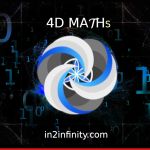When calculating the end of infinity. In modern mathematics, we often think that the end of the lumber line at the point of infinity is an incalculable event. However, from the mathematics of infinity, we work with the end of infinities all the time. For example, infinity minus one, infinity minus one really is the point also before we reach the number one, ie 0.999999999. because it reduces the infinite fraction of Mama Mama Mama Mama one one, which is an infinite of infinities. Whilst that might sound a little bit confusing to start off with what we can view it is from the other way round. If we imagine the number one as being a whole number than the number that is the fraction just below that whole number will be the number will be number one to infinity zero. I 1.0000 on into infinity, and at the end we put a minus one. This creates the infinite version of the number one from which all calculations are actually performed. This because we cannot actually reach the number one we can only use it as a unit measure. The unit measure was described my Archimedes which separated out the number one from other constants. In fact, in the mathematics of infinity, the numbers zero and one are of a particular function as is the number two, which is different from the number two as described by mathematics, which is actually the number 1.99999 to infinity. Similarly, the number one in mathematics has a 1.000 to infinity plus or minus one, as it’s number one. The number one is actually an unreachable event in terms of square numbers. For more information on boundaries of the one, you can see the infinity of one and its function with the square root and squaring functions, which are actually multiplicative and divisive, divisive within the reciprocal and hole number space. What is important here is that when we divide we are dividing by a number that is both a reciprocal to move along the number line towards the number one, whereas when we are in the whole number space, we are done dividing by a number that is of a whole variant and therefore we diminishes towards one.
More information on the structure of numbers, you can see our posts on the eight infinities on the number line and the nature of reciprocal and whole space and how that works within fourth dimensional mathematics. Returning to our subject matter of how do we calculate the end of infinity? Firstly, what we must realise is that when we divide the number we all work firstly, what we must realise is that we are working in a base system and a base system we’ll call it will cause an a base system will cause an interference with our mathematical calculations as we move through to infinity. However, we can analyse the base system number 10. And out of that analysis, begin to understand how we can unravel this complexity of base number systems lower than base infinity, so that we can begin to unravel the end of the infinite. To begin with, we realise that we have the number one which is actually 0.99999 to infinity. As we have discussed in our solution to pie when we have the number 2.0555 to infinity, divided by 37 equals 0.055555. To infinity, we know who have eek hit to the equilibrium point of the end of the infinite disruption. If we begin to think we can actually divide many reciprocals into the number nine however, the number seven holds a particularly interesting phenomena in the sense that it forms a six digit number code 142857. For those who are interested in vortex mathematics will know that this is the vortex code, which when divided by 1.125, will or 1.25 will obviously resolve into back into the nines and the zeros dividing the nine and 06 in sets of six into 999000, or 111000, which in turn disrupts the infinite
Other numbers such as 666 reveal the number 9909. For this reason, just quickly to clarify, for this reason, when we work in infinite number sets, we normally work in sets of six nines. Therefore we can put 999999 And divided by 142857, and we can resolve back to the number seven or more precisely, just under the number seven as the infinite fraction therefore is 999 and we can resolve seven the six nines are now can be divided by six sixes to receive the to reveal the number 1.5 which becomes the number 15 which in turn becomes a function of a division a division of three into two. If we put the numbers 3333 that are missing, we resolve to the number three therefore we can see that with the 666 resolving to 1.5 and the 333 are evolving to three the three and six are actually a halfing function which which does which do not appear in the equation that divides 999 by the seven vortex code. When we divide the number 999 by two to two, what we find is we get the number 4.5. Once again we have now divided the number nine in half and therefore we have created a division of nine into two what we are looking at here therefore begins to become simple ratios of dividing into two dividing into three. Again, when we come to the number eight, we reached the number 1.125 which as we know when it reaches the vortex code, we will resolve the vortex code into a regular 000909 He breaks up the vortex code into smaller parts. On the other hand when we get to a 99909 and divide that by 555 What we get is the number 1.8 It’s a doubling function of the nine but actually moves the one across. This means that actually in a sense, we have found the midpoint to the number of infinity whereby the number one is now being pushed forwards in space as it does so. So the number eight will emerge as another as another number that will disrupt the face 10 function and then will distort the infinite and as it moves through the infinite of number numbers so the numbers at the front of the number line will also change and that creates the difference between the pie equation that we have stipulated and the actual result when performed on one dimensional mathematics of a calculator. However, we can peer into the back end of the calculation and using what we have just said here, begin to understand the mathematics that resolves some of the reasons as to why those numbers are being distorted. So for example, the triple nine divided by 111 equals nine, which in a sense will just create a loop of itself whereas the 909 divided by five will create a 1.8 which is a nine doubled itself yeah whereas the two to two will end up having the nine so there we can see the four and the nine the sorry, the 222 and the 555 acting as a doubling function around the number nine, whereas the 111 Triple one is actually just a resolution of nine back into the number singular number nine. By analysing these codes, we are able to decode many of the things about base 10 and its effect on the infinite and in which case we can then begin to work backwards through the number by finding the bounce point by which that number reduces into infinity. The bounce point for fi just happens to be slap bang over its reciprocal. And that means the A creates a new constant with phi constant as other phi constant is created by bouncing phi over its reciprocal over the one so we can talk more about the bounce number five at another point in time, but that’s just a little bit about how to calculate infinite numbers at the back end of infinity. We can if you like just to finish off, just show a few things about the equations of one over three. If you think about it, it’s going to be what 333239909 So we know that that will resolve to the number three. And if it resolves to number three, then naturally that’s going to create a sort of wave if you like throughout the rest of the numbers. And as we know that 25 is a quarter you can imagine that that the quarter wave will be be just ordered itself as it moves through the numbers. We can see that we actually we have the seven code coming in a difference there between the actual real number if you like we have 2530325782 but then actually on the number on there the 12345678 the ninth we find a a division. So what happens is if we are able to calculate with the infinity of nines compared to the infinity of one does another nine point naught point no no, no, no nine into infinity. We find that there’s a differentiating difference at the after 909. And what that means is that’s where the point kicks in. What we find out is the difference there. There’s a seven seven which is very important 30 434 which is also seven and then we move into the break of the number code which goes into infinity which is 802-648-4869.
The number eight being very important there. We can talk more about the some of the number codes there that we’re seeing the but at the end of it what’s important here is that we have a seven seven, break it down to three four. And that shows us that we’re actually in a three four scenario here with the third and the quarter pie. And the seven seven there breaks obviously down into sevens and elevens. And so we can begin to understand we moves back step back a step and now we got the 909 and everything’s okay. So what we’re sort of saying here is then, as the numbers break down through the infinite through the number e being sort of a particular type of infinity, the number one being a particular type of infinity. Thus we arrive at the infinite of pi as Sensia. And actually those infinities can be calculated. So that’s just to give you a little bit of a rundown on some of that things are just to clarify if you take the number if you take the pie the pie equation we were talking about and you and you perform it with the number one or if you swap that out that one out for naught point 909 into infinity you will find there is a difference and you will find that you can find the number 77 breaking down into three four. And that’s where after that we fall into what we call the square root function, withdraw, no disintegrate the number further to infinity. But that’s and that will come through something called the square root of two, which is the division function and then we plus one and then we come to the square root of eight and you can square it that way. And that’s how that kind of works. Anyway, we can have more of that. You can see that in our pie solution, which looks at the square root of three and the two square roots to silver unified by the two silver means that’s one of our point solutions in the fourth dimension. And if you want to know more about that, we can do some more broadcasts at some point shortly. Thank you very much for listening. And until next time, this is Colin Power from into infinity decoding the pie solution.


